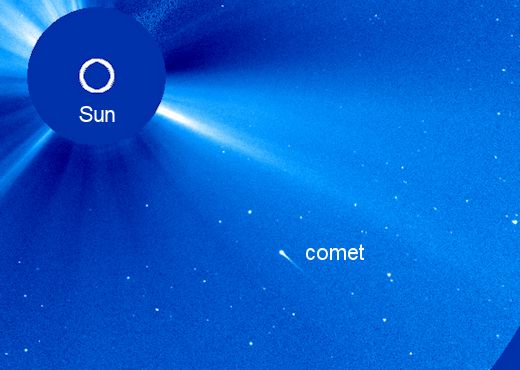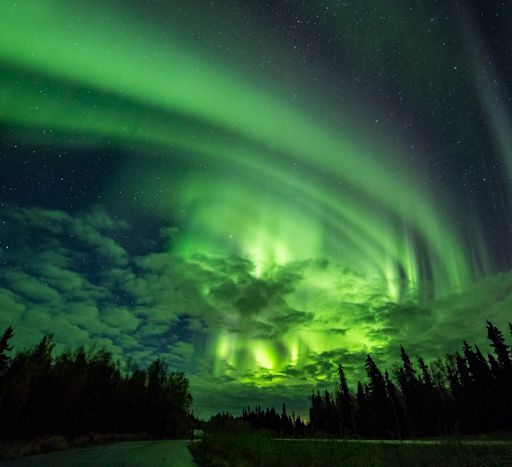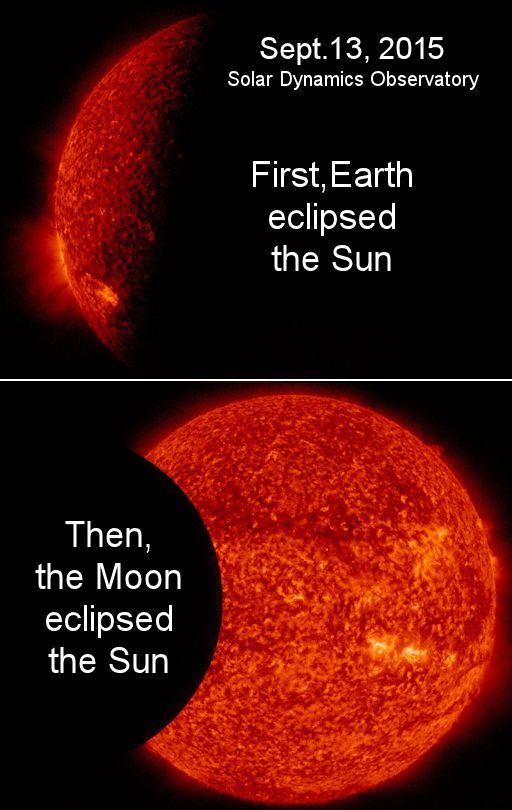Learn to photograph Northern Lights like a pro. Sign up for Peter Rosen's Aurora Photo Courses in Abisko National Park, winner of the TripAdvisor Certificate of Excellence Award 2015. | | |
ALMOST-QUIET SUN: An uptick in solar activity is underway as sunspot AR2415 begins to crackle with minor C-class solar flares. The sunspot has an unstable 'beta-gamma' magnetic field that harbors energy for even stronger flares. However, the next strong flare will be the first strong flare in more than a month. The odds favor a quick return to quiet conditions. Solar flare alerts: text or voice
SUNDIVING COMET: A comet is diving into the sun today. It appeared just hours ago in images from the Solar and Heliospheric Observatory (SOHO):

The comet is too close to the sun to see with the unaided eye. The only reason SOHO can see it is because the spacecraft can block the glare of the sun with an opaque disk--i.e., a coronagraph.
Sundiving comets are more common than you might think. SOHO has found more than 3000 of them. Most are members of the Kreutz family. Kreutz sungrazers are fragments from the breakup of a single giant comet many centuries ago. They get their name from 19th century German astronomer Heinrich Kreutz, who studied them in detail. Kreutz fragments pass by the sun and disintegrate almost every day. Most, measuring less than a few meters across, are too small to see, but occasionally a bigger fragment like this one attracts attention.
The comet is vaporizing furiously and is not expected to survive much longer. Monitor the SOHO realtime images page for developments.
Realtime Space Weather Photo Gallery
SOLAR WIND SPARKS AURORAS: Sometimes, the trick to seeing Northern Lights isn't a great space weather forecast. It's knowing where to find a break in the clouds. "Last night (Sept. 15th), the whole state of Alaska was clouded over," reports Marketa S Murray, "but we know about a few spots between the mountains where sometimes it is clear even when the rest of Alaska is overcast." She raced to one of those spots, and this is what she saw:

The display was caused by a stream of solar wind, which is buffeting Earth's magnetic field this week. It is just the latest episode in a month-long run of great auroras around the Arctic Circle.
One reason for the recent spate of auroras is the coming change of seasons. For reasons that are not fully understood, auroras love equinoxes. At this time of year even gentle gusts of solar wind can spark a nice display of Northern or Southern Lights.
NOAA forecasters estimate a 55% chance of more geomagnetic storms and auroras on Sept. 15-16 as the solar wind continues to blow. Aurora alerts: text or voice
Realtime Aurora Photo Gallery
DOUBLE ECLIPSE OF THE SUN: On Sept. 13th, the sun was eclipsed--twice! No one on Earth has ever seen anything like it. Indeed, it was only visible from Earth orbit. NASA's Solar Dynamics Observatory (SDO) recorded the event:

The double eclipse began around 06:30 UT when Earth passed directly between the sun and SDO. The observatory watched as the body of our planet moved slowly across the face of the sun, producing a near black-out. When the Earth finally moved aside about an hour later, another eclipse was in progress. This time, the Moon was in the way. A movie from the SDO science team explains the crazy-perfect alignment required for such a view. Update: This picture shows the Moon and the Earth in front of the sun at the same time.
(In the snaphots above, note how the edge of the Earth looks so much fuzzier than the edge of the Moon. That's because our planet has a thick atmosphere and the Moon does not.)
Meanwhile on Earth, an ordinary partial eclipse was visible. People in South Africa and parts of Antarctica saw the Moon pass in front of the sun, off-center, producing crescent-shaped shadows and strange sunrises. Check the realtime photo gallery for their images.
Realtime Space Weather Photo Gallery
Realtime Sprite Photo Gallery
Realtime NLC Photo Gallery
Every night, a network of NASA all-sky cameras scans the skies above the United States for meteoritic fireballs. Automated software maintained by NASA's Meteoroid Environment Office calculates their orbits, velocity, penetration depth in Earth's atmosphere and many other characteristics. Daily results are presented here on Spaceweather.com.
On Sep. 15, 2015, the network reported 30 fireballs.
(28 sporadics, 2 September epsilon Perseids)

In this diagram of the inner solar system, all of the fireball orbits intersect at a single point--Earth. The orbits are color-coded by velocity, from slow (red) to fast (blue). [Larger image] [movies]
Potentially Hazardous Asteroids (
PHAs) are space rocks larger than approximately 100m that can come closer to Earth than 0.05 AU. None of the known PHAs is on a collision course with our planet, although astronomers are finding
new ones all the time.
On September 15, 2015 there were potentially hazardous asteroids.
Notes: LD means "Lunar Distance." 1 LD = 384,401 km, the distance between Earth and the Moon. 1 LD also equals 0.00256 AU. MAG is the visual magnitude of the asteroid on the date of closest approach. | | The official U.S. government space weather bureau |
| | The first place to look for information about sundogs, pillars, rainbows and related phenomena. |
| | Researchers call it a "Hubble for the sun." SDO is the most advanced solar observatory ever. |
| | 3D views of the sun from NASA's Solar and Terrestrial Relations Observatory |
| | Realtime and archival images of the Sun from SOHO. |
| | from the NOAA Space Environment Center |
| | the underlying science of space weather |
| | Web-based high school science course with free enrollment |

